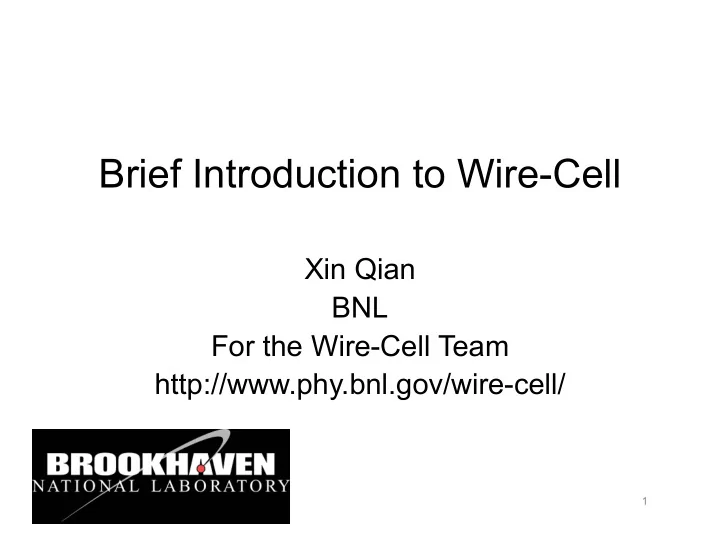

Brief Introduction to Wire-Cell Xin Qian BNL For the Wire-Cell Team http://www.phy.bnl.gov/wire-cell/ 1
Challenges of Event Reconstruction in LArTPCs • Event topology: – Tracks, showers, unknown vertex in LArTPCs – Simple tracks in collider’s gas TPCs • Wire vs. Pixel readout – Large LArTPCs has to use wire readout due to power consumption of electronics and costs – Puedo-3D detector 2
Review of Existing Approaches 2D matching 3D Wire-Cell Approach 3
Wire-Cell Imaging LArTPC Signal Formation slicing tiling merging solving 4
Solving for Images v3 u2 True Hits 2 T 1 v2 (B W G C ) V (B W G C ) u1 BW 2 v1 T 1 1 T 1 0 C (G V G) G V BW BW BW Fake C At fixed time Hits • C: charge in each (merged) cell • G: Geometry matrix connecting cells and wires • W: charge in each single wire • Use two-plane as an • B: Geometry matrix example connecting merged wires and • Red points are true hits single wires • Blue ones are fake hits • V BW : Covariance matrix describing uncertainty in wire W G C charge 5
Same formulism for DUNE Wrapped Wire 2 T 1 (B W ) (B W ) G C V G C BW 1 1 1 T T C (G V G) G V BW BW BW • C: charge in each (merged) cell • G: Geometry matrix connecting cells and channels • W: charge in each single channel • B: Geometry matrix connecting merged channels and single channels • V BW : Covariance matrix describing uncertainty in channel charge Xiaoyue Li (Stony Brook) 6
With Charge Without Charge More 3D events can be found at http://www.phy.bnl.gov/wire-cell/bee/ Bee: interactive 3D display (Chao 7 Zhang)
The Usage of Connectivity • We can add penalty to χ 2 based on connectivity and single channel assumption – For example, if we remove a merged cell that are connected to good cells in the adjacent time slice, we can add penalty in χ 2 to increase the chi- square value less chance to be chosen as the optimal solution • For later pattern recognition, we can also cluster with all merged cell, and then remove bad ones taking into account connectivity 8
Connectivity information • Use the connectivity information to choose the optimal imaging solution – Penalty term added in chisquare Without Connectivity With Connectivity 9
Parallel vs. Perpendicular APA Perpendicular APA X-Z View X-U View X-V View Parallel APA The improvement in imaging is from every 2D view! 10
Strategy Comparison 2D Matching 3D Tomography • Start with 2D (time+wire • Start with 2D (wire+wire+wire x 3) at fixed time slice) • 2D pattern recognition • 2D image reconstruction – Particle track/cluster – Explicit Time + Geometry + information Charge information – Some connectivity information • Matching 2D patterns into can be used 3D objects • 3D image reconstruction – Time information (start/end of clusters) – Straight forward – Geometry information • 3D pattern recognition – Some charge information to – Particle track/cluster information remove ambiguities in (tracks, showers) matching Each approach uses the same set information in different order! 11
Discussion (Pros) • Wire-Cell Imaging tells us which hits CANNOT be associated together • Hits from different time slice CANNOT be associated together ( time information ) • Hits from wires that are not crossing each other CANNOT be associated together ( geometry information ) • Hits with “different” charge is UNLIKELY to be associated together ( charge information ) • Advantages: – Utilize full TPC information (time/geometry/charge) – Natural way to suppress electronics noise – Track/shower hypothesis not used, delay the pattern recognition process better automated – Expected to be better for complicated topologies 12
Discussions (Cons) • Likely worse performance for 2-plane configuration – With 2-plane configuration, the power of the geometry information is strongly reduced – It is important to use track/shower hypothesis early to reduce ambiguities • Stringent requirements on TPC performances – Relative time among hits from different planes – Charge reconstruction from induction plane • Use this feature for calibration purpose – Also dead channels (more sensitive to inefficiency) • High resources requirement on the memory and speed 13
Wire-Cell Pattern Recognition • Given the 3D images, pattern recognition is performed with the track and shower hypotheses • Operations are all “local” i.e. Hough transformation, Crawler, Vertex fitting/merging … • Too many different topologies many corner cases 14
Wire-Cell Solve the Reconstruction Problem? • No! – The 3D pattern recognition is still an open question Pandora 3D pattern recognition, PMA, LineCluster … – With recognized pattern, how to do the fine tracking? Projection Matching Algorithm – Energy calculation, angle determination, PID … • What’s the ultimate solution for pattern recognition? – Human-directed pattern correction is being developed with modern web-based tools Bee 2.0 – Deep learning? 15
Related Technical Progress • Bee: – Improved on memory usage and UI responsiveness and added object picking. – Further performance improvements and a UI redesign coming. • Wire Cell: – Excellent results from prototype noise removal on MicroBooNE data. – Porting to Wire Cell Toolkit is underway. – LArSoft Noise Subtraction Service Interface developed. – WCT NSS implementation will provide first LS/WC integration. – Will adopt service-based model for future WC imaging, etc, integration. 16
Summary • Advantages and disadvantages of Wire- Cell approach are discussed • Wire-Cell imaging is in a good shape • More work is needed for the 3D pattern recognition • Bee 2.0 is under development • Integration with LarSoft is in progress 17
Recommend
More recommend